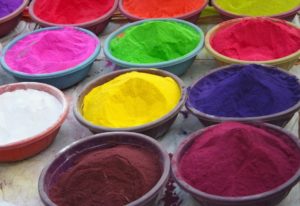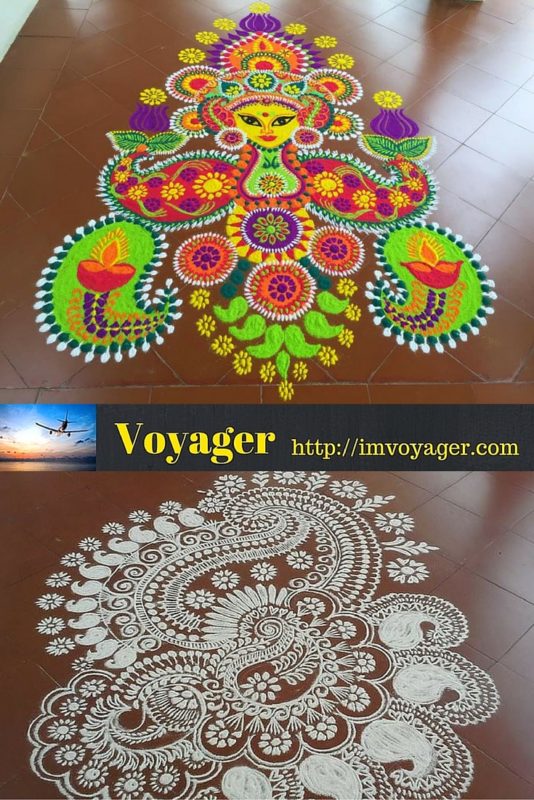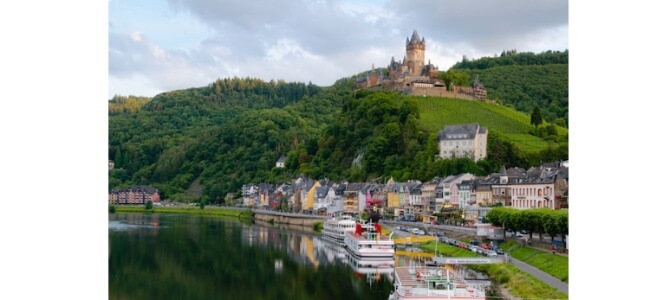The chirping of the birds woke me up and I quickly slithered off the bed and ran towards the front door and out into the courtyard. It was dawn, and the first rays of the sun were just managing to pierce the darkness. My mother squatted before the front door, humming a morning Mantra (Sanskrit Hymn) and drawing an intricate geometrical design using white rice flour. I gazed in awe as she skillfully let the powder drop through her fingers as her hand moved deftly and, Lo and behold, in a few minutes, a beautiful design graced the floor.
I must have been barely three years old and this was how, like many other Indians, I grew up, admiring this traditional and ancient art of India, which is known as Rangoli. This art has been passed from one generation to another and is a living and pulsating art form in millions of homes in India. The earliest mention of this art form is found in Indian Mythological works like the Ramayana.
The significance and importance of Rangoli
Rangoli is an art form that primarily consists of the drawing of intricate, geometric designs and religious motifs. The material used for the drawing range from rice flour, colored rice grains, charcoal, red soil and flowers of different colors. It is remarkable that this art requires materials that are freely available in all households irrespective of their material status.

The Rangoli motifs are primarily associated with auspiciousness and spirituality. One can find these adorning the courtyards of most houses in the South of India every morning. Rangoli motifs also adorn the place or room specifically designated for religious rites and worship that take place in Hindu homes. Festivals are another occasion when bright and colorful Rangolis beckon one to Indian homes. The tradition and variety of Rangoli is as rich as the diversity of India, and across the country various styles of Rangoli to mark different occasions can be found. But the underlying philosophy behind this colorful art form remains the same; they are believed to be the harbingers of peace, prosperity and well being by generating a positive energy.
Diwali, the dazzling festival of lights would never be complete without the presence of bright and multi-hued Rangoli designs that grace the courtyards of homes across the length and breadth of India. Rangoli for Diwali captures the spirit of the festival with all its joy and celebration. The motifs generally used during Diwali include Diyas (Lamps), Lotus, Lakshmi-The Goddess of Wealth and the popular Hindu God, Lord Ganesh.
Another important and beautiful variation of Rangoli is to be found in the southern states of Kerala and Tamil Nadu, in the form of Pookalam, an art form that makes use of multi colored flowers to come up with a floral Rangoli. During the ten days of the festival of Onam, these beautiful designs grace each and every house.
Today stencils and stickers are available to make it that much easier to make Rangoli drawings, but the skill and spirit of the original way of drawing Rangoli patterns can never be replaced.











I saw rangolis being created many times when travelling in India. They are gorgeous to photograph and to view.
That’s nice to know. 🙂 Yes, they are good to be photographed and to view.
This is an amazing piece of art. Really impressive.
Thank you. 🙂
I love the intricate patterns in the flowers. That must be so hard to do. I can’t imagine how much effort it must take to get these patterns so perfect.
Thank you Shobha. It requires a lot of patience and during festivals, girls and ladies together make those patterns with flowers and petals.
Honestly I never heard about it. But looks impressive, like I understand needs a lot of patient for it? 🙂 I saw something similar in movie “Samsara” and was amazing how people can be accurate to making such drawings 🙂 Thank you for introduction 🙂 I love to learn new things 🙂
Yes, it requires patience and if you are artistic, you could come up with beautiful rangolis! I will now search for this movie – Samsara. 🙂
I’ve never heard of rangoli so I’m really glad you shared this with everyone. What I especially love is your wonderful description of your waking as a child. Your fondness for your own culture shines through!
Thank you Carlie. Happy you like the narration. 🙂
Very Beutiful Rangoli Designs I love This Rangoli Designs………….
This reminds me of Tibetan sand mandalas. So beautiful and so interesting that these are made from household good. I love it!
Thank you Rob.:)
Those look incredible! I love all the beautiful unique art forms found around the world.
Thank you Kevin. 🙂
Ive never heard of this but it is so fascinating! Such intricate and beautiful pieces! Thanks for sharing!
Thank you Tarah. 🙂
What gorgeous artwork! Things like this are what really keep drawing me to India. I hope to go soon.
Thank you Amanda. 🙂
First time Ivé heard of Rangoli. Its such a beautiful art, love all the colours!
I make Rangoli patterns every year for Diwali. It is so much fun and looks awesome with candlelights on it. This is such a lovely tradition and as tired as I can be, I know my Diwali without Rangoli will never be festive. Well covered.
That’s good to know Ami.
This is very interesting and something I didn’t know. I love the colours and the intricate patterns and I cannot even begin to imagine what it must be like to create this: so precise and so beautiful!
Thank you Marta. Rangoli does require skill, patience and time.
Oh wow this is really colorful and creative art! Would love to see this one day in India. the art called pookalam is really beautiful!
Thank you Carlo.
This is beautiful. I’ve seen designs like it but wasn’t aware that it was Rangoli.
Yes, Rangoli is such an art that each one try their own form and it looks wonderful!
Just followed your link from Broken Backpack- thank-you so much for this, I needed a bit of positivity this weekend! What a beautiful art form and I love the accessibility you talk about- the sort of creative outlook that everyone can afford.
Thank you Katie. Really glad to know this post brought some positivity.
Loved these designs, saving them up for my next Diwali.
I too indulge a bit trying out these, though nowhere near being an expert.
all designs are great and definitely will I used in upcoming Diwali thanks and also keep sharing this…
wow, amazing this is really colorful and creative art! I will use Pongal festival thank you for sharing this post